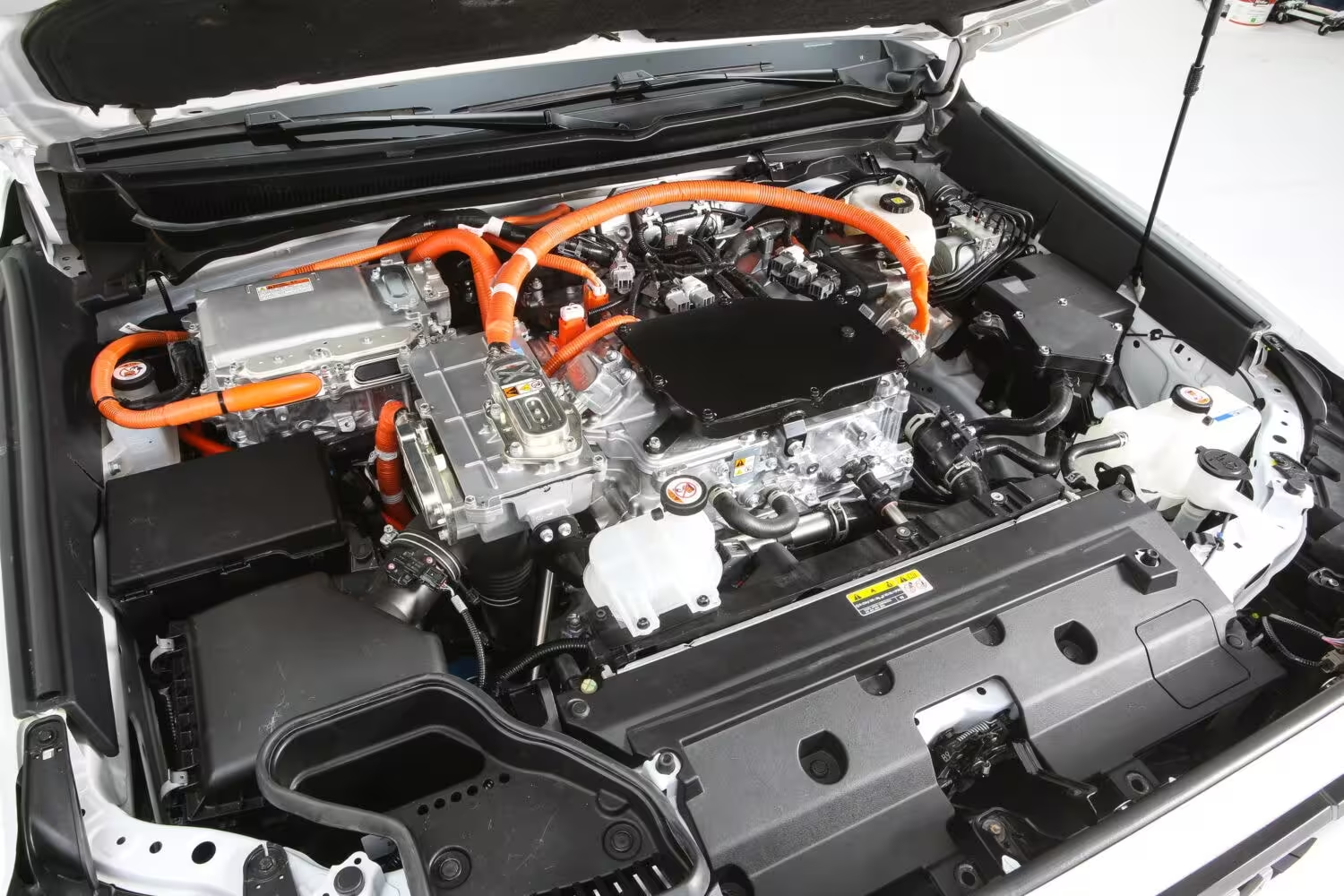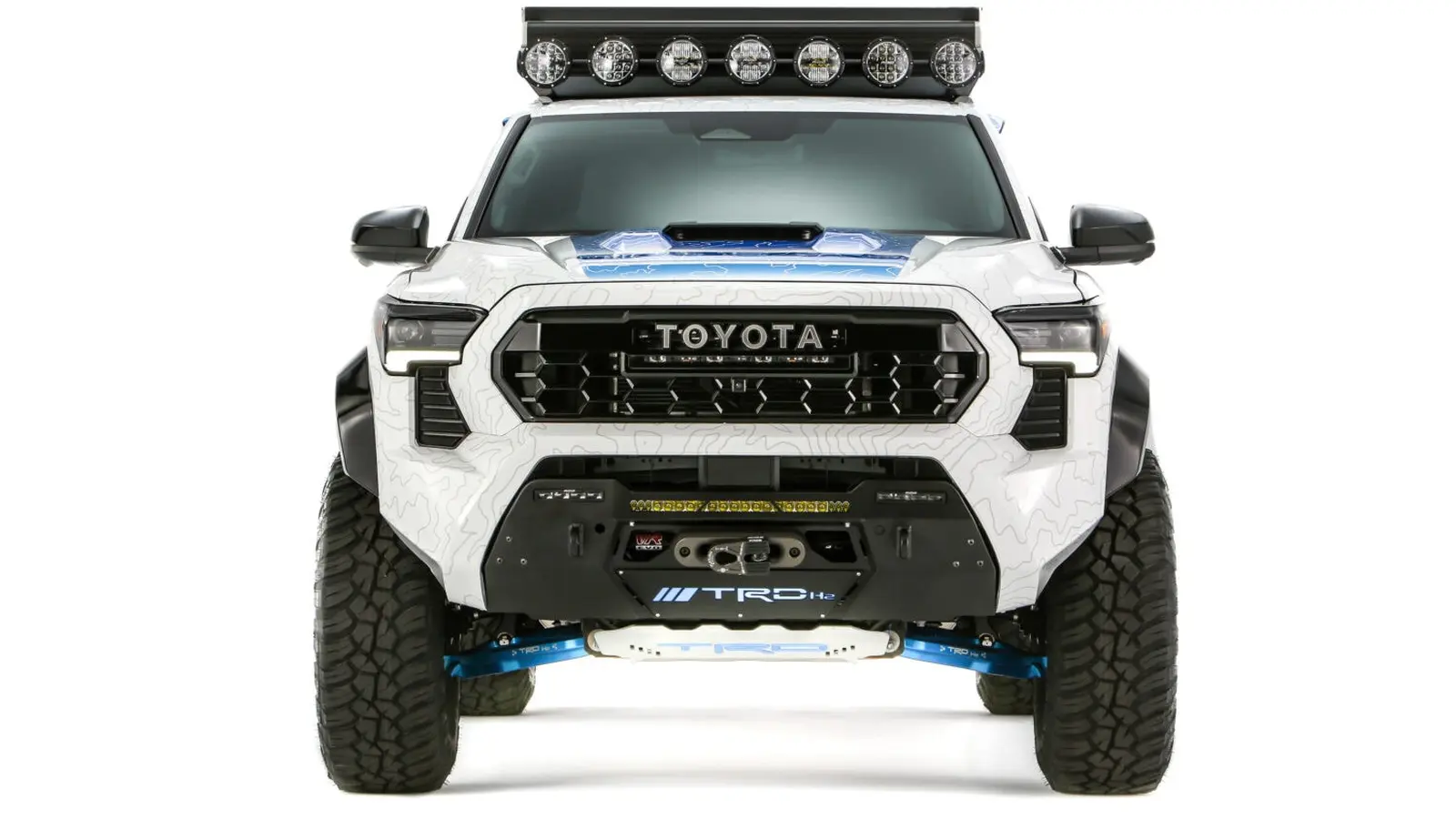6 Minutes
Toyota's Tacoma H2-Overlander turns exhaust into campsite water
Toyota arrived at SEMA 2025 with an attention-grabbing show truck: the Tacoma H2-Overlander. Built by Toyota Racing Development (TRD) as part of the automaker's 'Powered by Possibility' series of concept conversions, this Tacoma swaps its conventional internal-combustion heart for a hydrogen fuel-cell and battery-electric powertrain — and deliberately captures the resulting water for outdoor use.
The headline here isn't just hydrogen propulsion or electric torque. It's the patent-pending exhaust water recovery system TRD built into the truck, designed to collect and filter the distilled water produced by the fuel cell reaction so it can be reused for washing, showering, campsite chores and other non-potable applications.

Powertrain and technical highlights
Toyota removed the donor pickup's 2.4-liter TNGA-F combustion engine and installed a second-generation fuel-cell stack — the same tech that powers the Mirai — paired with a 24.9-kWh lithium-ion battery and two electric motors (one per axle). The package yields a combined output of roughly 547 horsepower and produces only water as a direct emission.
Key specs and hardware:
- Second-generation Mirai fuel-cell stack
- Three hydrogen tanks mounted in the frame rails, total capacity ~13 lb (6 kg)
- 24.9-kWh lithium-ion battery
- Dual electric motors, AWD configuration, 547 hp combined
- 15-kW power takeoff (PTO) capability for external power
- Front limited-slip differential and rear electronic locking differential
- Tundra-inspired long-travel billet kit, Fox 2.5 Performance Elite shocks
- 17-inch wheels with 35-inch off-road tires and Tundra-sourced brakes

Those figures put the H2-Overlander in an interesting performance bracket for a concept overlander: powerful enough for heavy off-road use while offering on-demand electrical output for camp life or emergency scenarios.
How the water recovery system works — and what it means
Fuel cells generate electricity by combining hydrogen and oxygen; the chemical reaction produces electricity and water vapor as the only byproduct. In most fuel-cell vehicles, that water simply exits the exhaust and is lost to the environment. TRD's novel system captures that moisture, filters it, and stores it on the vehicle for practical use.
Toyota stresses that the water is distilled and therefore not recommended for drinking without additional mineralization or treatment, but it is ideal for washing, showering, cleaning gear and other campsite needs. Toyota hasn't released exact recovery rates for the Tacoma build, but Mirai owners typically report around 2.6 gallons (10 liters) of water formed per 62 miles (100 km) under certain conditions — a useful benchmark for what an overlander might expect on long runs.

On-board power: more than just lights and a fridge
Beyond water, the Tacoma H2-Overlander doubles as a mobile power source. Its 15-kW PTO can run high-demand appliances, power tools or even act as an emergency generator for a home in a blackout. Toyota claims this capacity is enough to simultaneously charge two electric vehicles or feed household loads, making the truck a multi-role platform for remote work, overlanding and disaster relief.
Quote from a TRD spokesperson at SEMA: 'We wanted to show a vehicle that doesn't just take you farther into the backcountry, but also brings essential resources — water and power — with you.'
Chassis, suspension and overland-ready design
TRD outfitted the Tacoma with heavy-duty bumpers, roof-mounted overland camper panels made from recycled carbon-fiber aero components, winch, dual swing-outs and plentiful recovery points. The bed features tiedowns and a dedicated storage system for recovery boards, while auxiliary lighting — from front light bars to camp-specific lamps — is spread across the build.
Under the skin, the truck uses a Tundra-inspired long-travel kit built in billet, heavy-duty Fox 2.5 Performance Elite Series shocks and larger brake hardware borrowed from Toyota's full-size models. These upgrades, along with 35-inch tires, turn the Tacoma into a credible off-road platform that keeps ride quality and articulation in mind for serious overlanding.

Market context and potential
Hydrogen fuel-cell technology has long been discussed as a complementary solution to battery-electric vehicles, especially where range, rapid refueling and heavy-duty applications matter. For off-road and overland use, fuel cells offer quiet operation and predictable range, while the byproduct water becomes a surprisingly valuable resource for extended trips in arid regions.
Toyota's H2-Overlander is unlikely to be a production model in this exact form — many SEMA builds push boundaries that would require regulatory approvals or extensive re-engineering for street legality. Still, the concept serves as a living laboratory. The most practical takeaway is likely the water recovery system: a compact, efficient way to harvest distilled water from fuel-cell exhaust that could migrate into RVs, expedition vehicles, or even standard fuel-cell models in the future.
Practical questions answered
- Can you drink the recovered water? No — the captured water is distilled and lacks minerals; it should be used for washing and cleaning unless further treated for potable use.
- Does the truck still perform off-road? Yes — the build pairs EV torque, upgraded suspension and large off-road tires to retain strong off-road capability.
- Is this street-legal? The concept may not meet regulations in all regions; production-ready versions would need certification and conformity to local laws.
Final thoughts
The Tacoma H2-Overlander highlights how automakers can combine alternative powertrains with practical, real-world features that appeal to enthusiasts and utility-minded buyers alike. It’s part demonstration of hydrogen's potential, part TRD showpiece, and part idea incubator — particularly for how we might harvest byproducts of clean propulsion to improve autonomy in remote living and travel.
Whether or not Toyota brings water-recovery hardware to dealerships, the H2-Overlander points to a future where powertrain innovation directly enhances the on-board amenities that overlanders and adventurers value most: reliable power, self-sufficiency and usable water when it matters.
Source: autoevolution
Comments
mechbyte
is this even true? they say distilled water from fuel cell exhaust is ok for washing but can it pick up road oils or tank contaminants, or is that all filtered out? seems cool but i'd want lab tests
axleForge
Wow ok this is wild, capturing fuel-cell water for showers? If real, total game changer for desert trips. Curious how it handles freezing temps, filter lifespan, etc...


Leave a Comment